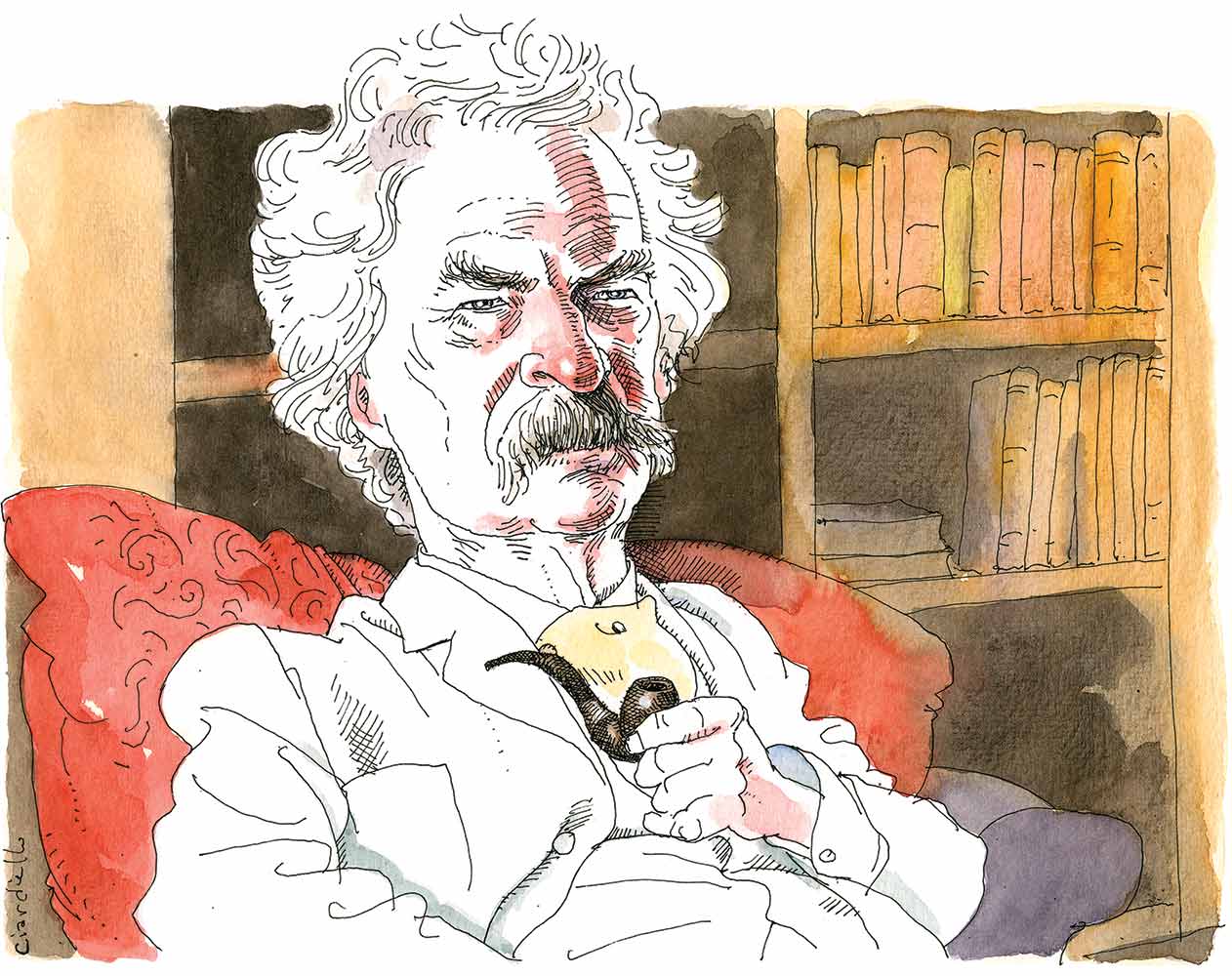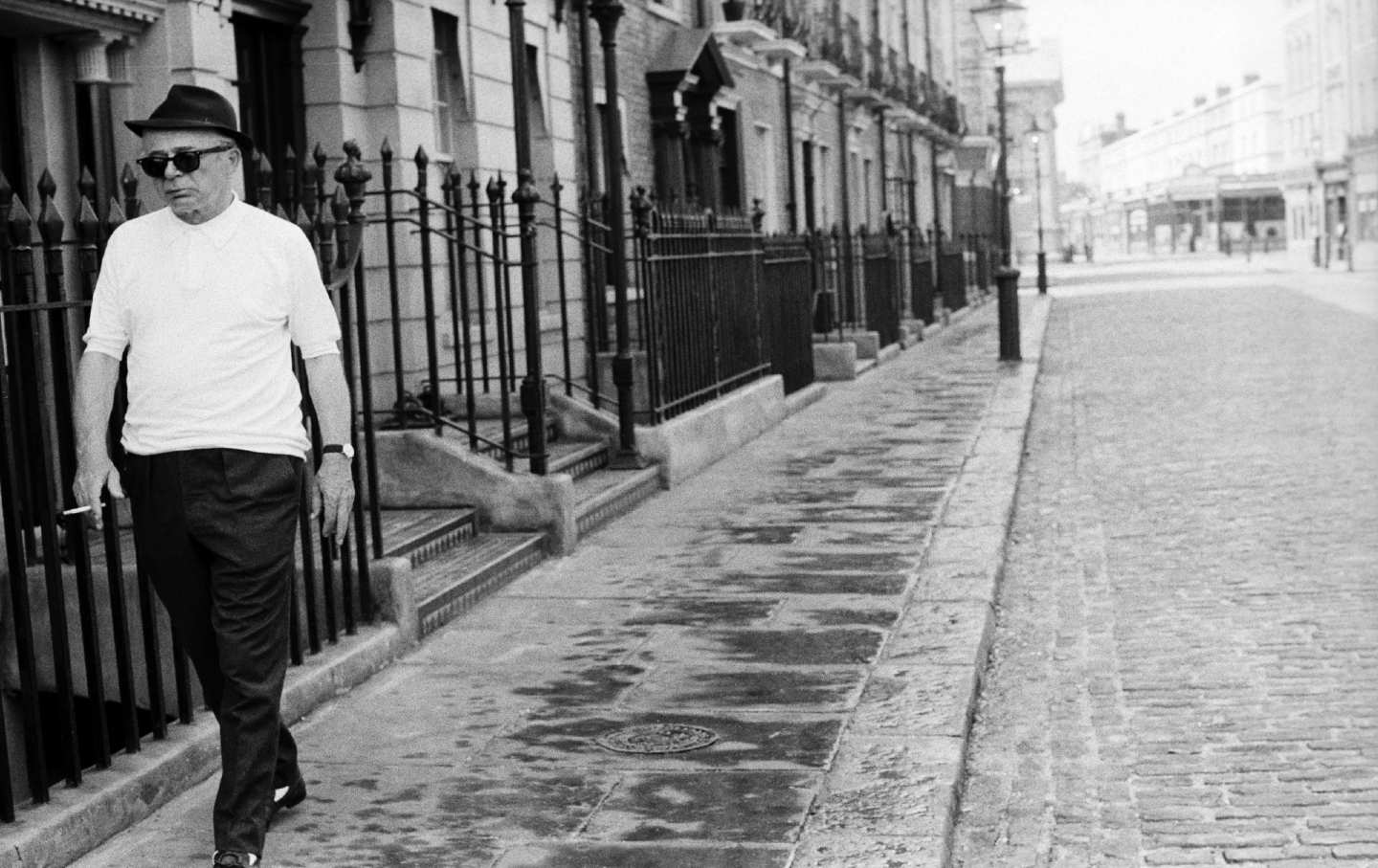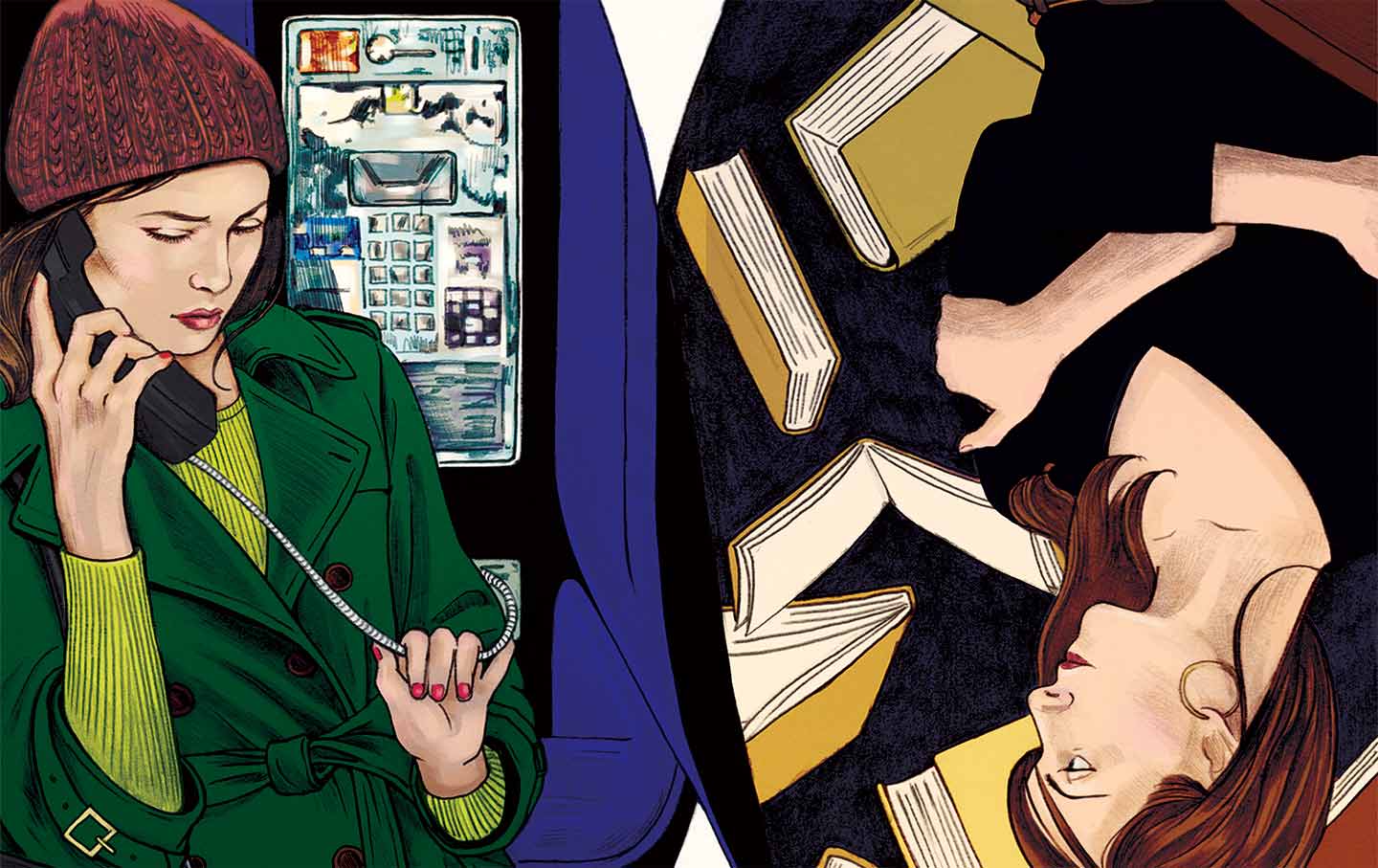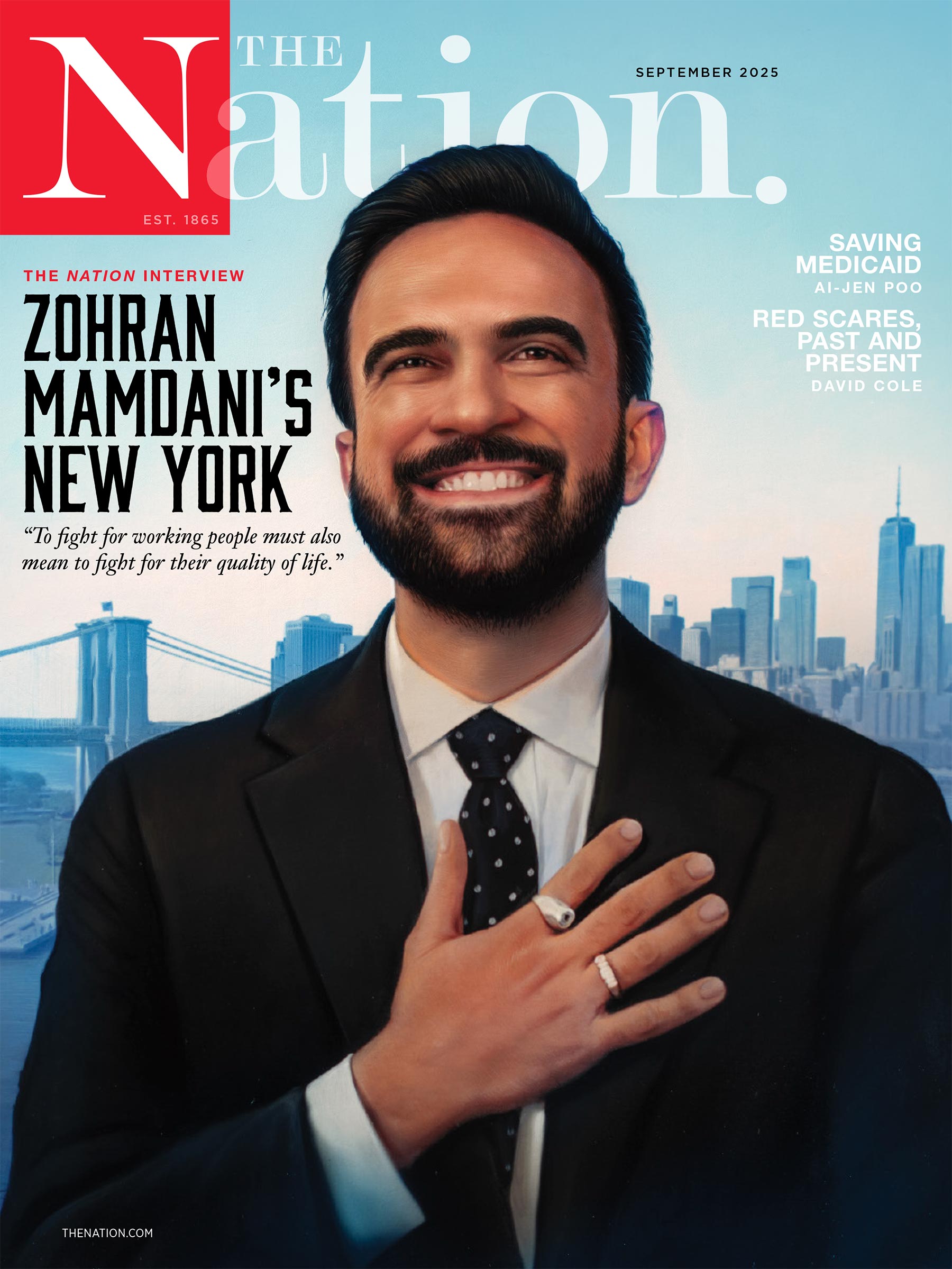The Adventures of Samuel Clemens
Mark Twain’s many lives.
Mark Twain’s Many Lives
A new biography depicts the different sides of the American author.

Some people live several lives. Mark Twain lived half a dozen. As a boy in Hannibal, Missouri, he saw his family reduced to living in cramped quarters above a drugstore. As a world-renowned author, he and his wife built an 11,500-square-foot home with 25 rooms, balconies, turrets, and marble floors. In Twain’s impoverished 20s, he traveled to Nevada by stagecoach, sleeping atop mailbags. Decades later, he hired private railway cars. Before writing the books that made him famous, he served in a Confederate militia, searched for gold in the Sierra Nevada, and worked as a newspaper reporter in San Francisco and what today is Hawaii. By the end of Twain’s life, the czar of Russia and several other monarchs would happily receive him, Andrew Carnegie would invite him for dinner, and Woodrow Wilson (then the president of Princeton University) would play miniature golf with him. To borrow a line from his contemporary Walt Whitman, Twain’s life truly contained multitudes.
Multitudinous as well was the geyser of his work. Twain left some 30 books and pamphlets, thousands of newspaper and magazine pieces, as well as notebooks, unpublished manuscripts, and a mountainous three-volume autobiography whose mixture of fact and fancy have kept scholars busy for decades. Not without reason did one editor title an anthology Mark Twain in Eruption. Furthermore, much of Twain’s work happened onstage: One of his marathon speaking tours featured 103 appearances in the United States and Canada; another took 15 months and a zigzagging 53,000 miles to circle the globe.
Books in review
Mark Twain
Buy this bookRon Chernow’s massive but highly readable new biography, titled simply Mark Twain, covers the entire volcano, but three phases of this extraordinary life stand out. First is Twain the writer, particularly the author of his two finest books, The Adventures of Huckleberry Finn and Life on the Mississippi. The great river flows through their pages, filled like life itself with treacherous bends, hidden snags and currents, and unexpected joys. With a few exceptions, such as The Adventures of Tom Sawyer, the rest of his work today has a whiff of the archaic. Would we still read The Prince and the Pauper or A Connecticut Yankee in King Arthur’s Court if they’d been written by someone else? When it comes to princes and kings, no one outshines the Duke and the Dauphin, the fake royalty in Huckleberry Finn.
The second Twain is the world-famous celebrity, who basked in applause on almost every continent. And the third is the author in his final years, multiply bereaved, enduring sorrows of which the public knew little, and manifesting a strange and revealing fixation.
He was born Samuel Clemens in 1835, in the small village of Florida, Missouri. When he was 3, the family moved to the nearby Mississippi River town of Hannibal, the “St. Petersburg” of his novels. His father managed to run one small business after another into the ground, accumulating debts that forced him to take a job as a grocery clerk and his wife to take in boarders. He died when Sam was 11. The boy had only a few years of school, did various odd jobs, became a printer’s apprentice, and worked briefly for his brother Orion, who owned a small newspaper. At 17, he left home for several years as a wandering printer and typesetter, living briefly with a married sister in St. Louis and plying his trade as far away as Philadelphia and New York.
At 21, he started training as a riverboat pilot, a post he had long dreamed of, the profession from which he would take his pen name. Licensed two years later, he would at one point pilot the largest steamboat on the Mississippi, one of the marvelous machines—belching smoke, sparks, and flaming embers from their high twin stacks—that had reduced travel time on the country’s great central artery from weeks to days. No wonder Twain hoped to “follow the river the rest of my days, and die at the wheel.” He enjoyed only two more years of life as a member of what Chernow calls “the undisputed royalty of this floating kingdom” before the Civil War brought that magical existence to an end.
Then came Twain’s brief spell fighting for the Confederacy—he took part in only one skirmish—before he and his brother took that stagecoach westward. Already he had published a few sketches in newspapers, and by his late 20s in California, he was making a living from his pen, writing both fact and fiction. The breakthrough that ignited his renown was The Innocents Abroad, published in 1869, when Twain was 33.
Despite the imposing length of Chernow’s book, he deals too swiftly with this crucial early period, especially Twain’s childhood in Hannibal and his career on the Mississippi River, the years that gave birth to his two masterworks. In this biography of well over 1,000 pages, Twain has left Hannibal by page 41 and his riverboat pilot’s job by page 64.
Twain’s own autobiography provides far more pages on his childhood, recounting, for example, his forays into the forbidden, such as his account of skating, “probably without permission,” on the frozen Mississippi under the winter moonlight, as ice floes break up and separate him and a friend from land. And beyond Twain himself, what lay behind his peerless picture of American con men in the Duke and the Dauphin, who try temperance preaching, patent medicines, and phrenology before posing as fallen nobility and famous actors? Are there traces of the small-town swindlers passing through Hannibal, or working the river’s steamboats, who might have been raw material for them?
To be fair, Chernow does tell us about the later experiences that profoundly changed how Twain thought about something he had taken for granted as a child—slavery. Many people in Hannibal owned slaves, including, before his business reverses, Twain’s own father. By contrast, Twain’s wife, Olivia, or Livy, whom he married in 1870, came from a wealthy clan of abolitionists who had financially supported a stop on the Underground Railroad. The writer also had several memorable encounters, such as a long conversation in 1874 with his sister-in-law’s Black cook, who told him how, two decades earlier in Virginia, she had seen her husband and seven children auctioned off in chains; only one child did she ever see again. It was then that Twain began to fully realize what was in the hearts of the dozen shackled slaves he once saw as a child, on the dock in Hannibal, waiting to be shipped downriver. Without this broadening of his awareness, we might never have had the figure of the runaway Jim.
As much as any white American writer of his time, Twain came to see slavery and its aftereffects as the country’s original sin. Beyond that, he put his purse where his principles were by devising, Chernow writes, “his own form of racial reparations”: Once Twain was wealthy, he financially supported many Black people, among them one of the first such students to enter Yale Law School. Warner T. McGuinn would later become a Baltimore city councilman and a successful lawyer who, long after Twain’s death, mentored and referred cases to another Black lawyer just starting his career: Thurgood Marshall.
The second Twain we meet in the book is the man who, as Chernow writes, “fairly invented our celebrity culture.” If Huck Finn was the archetypal outsider, Mark Twain the celebrity was the consummate insider, the ultimate riposte to his ne’er-do-well father. His fame crossed class boundaries in a way that’s hard to imagine today. No other American writer could appear in a New Orleans saloon, a Kentucky general store, or at the Metropolitan Opera and have everyone instantly know who he was. It’s hard to imagine his close contemporary Henry James, for example, deigning even to set foot in New Orleans or Kentucky, much less being recognized there. When Twain arrived in England in 1907, dockworkers cheered as he got off the ship—as did the students at Oxford when he received an honorary degree there. For his 70th birthday, his publisher gave him a dinner with a 40-piece orchestra, 172 guests, and, as a party favor for each, a foot-high bust of the author. (Note to my publisher: I have a birthday coming up.)
His was not, however, an empty celebrityhood like that of, say, the older Hemingway, the blustery “Papa” who posed with the lions and leopards he’d shot after his best work was behind him. Rather, starting with Twain’s first lecture at the age of 30, performing was central to his work. Sadly, he died in 1910—too early to leave any recordings of his performances.
No one knows the full total of his readings, lectures, commencement addresses, and after-dinner speeches, but at least 835 of them produced enough of a written record to count. Whether he was speaking at Carnegie Hall or in a California mining town or before 850 convicts at a prison, Twain kept his listeners enthralled. All of this helped hone his writing, just as Shakespeare’s time onstage did his. Chernow quotes one observer noting that Twain read each audience as closely “as a lawyer scans his jury in a death trial.” He learned timing and the value of a raised eyebrow or a calculated pause, and discovered that the best humor can be deadpan. (He turned down invitations to speak in churches, where people were “afraid to laugh.”)
At a banquet of Union Army veterans in 1879, after the famously impassive Ulysses S. Grant had sat through 14 speeches “like a graven image,” Twain felt triumphant that he made the general laugh “till the tears came.” When beginning a new tour, he had his lecture agents start him out in smaller towns so he could perfect his material before hitting the big-city halls. “For an hour and fifteen minutes,” he wrote after one triumphant appearance, “I was in paradise.”
Furthermore, Twain put his celebrity status to use by speaking out for his beliefs. His reckoning with slavery led to a passionate rage at other injustices. He wrote, spoke, and lobbied, for example, against the ruthless forced labor system that King Leopold II of Belgium imposed on the Congo. And against the grain of American public opinion, he vigorously protested the brutal colonial war that the United States waged in the Philippines. “I am opposed,” he said, “to having the eagle put its talons on any other land.”
Unlike most Twain biographies, however, nearly half of Chernow’s behemoth is devoted to the last, increasingly difficult decade and a half of the writer’s life—and it is in these pages that we meet the third Twain. It is a haunting and memorable portrait, because his private life in this period was so different from the second Twain, which the public continued to see, the magisterial white-haired luminary with a brilliant quip for any occasion.
Twain and Livy had lost one child in infancy and now had three daughters. The eldest, Susy, seemed to be having a same-sex love affair that the family, worried about its public image, did its best to ignore. In 1896, Susy, who was particularly close to her father, sickened and died of spinal meningitis in a matter of days. Always quick to lacerate himself, Twain felt that he had unduly neglected her. Then Livy’s fragile health worsened, leading to unending rounds of new doctors, spas, rest cures, and warm climates. For several stretches, doctors bizarrely insisted that, to avoid straining her heart, the two should not see each other for days or even weeks at a time. In 1904, when they were far from home, in a palatial rented villa in Florence, Italy, Livy’s heart failed.
Popular
“swipe left below to view more authors”Swipe →Twain lived out his final years in a restless circuit between Connecticut, Bermuda, New York City, and a summer retreat upstate, fretting constantly about his youngest daughter, Jean, who suffered from epilepsy. Anyone who has ever lived with an epileptic in the years before today’s treatments knows the strain of fearing and helplessly watching a grand mal seizure. While keeping Jean’s illness a secret, the author and his other surviving daughter, Clara, embarked on a long search for the right physician or sanatorium.
To manage the household and help with his ocean of correspondence, Twain hired a young live-in secretary, Isabel Lyon. Rivalries soared. Jean feared, correctly, that she was being exiled because of her epilepsy. The unsteady Clara—who at one point had a breakdown that put her in a sanatorium—was fiercely jealous of Lyon, whom many suspected of scheming to marry Twain. Lyon referred to him as “the King” and took on wifely duties such as cutting his hair.
The whole quarrelsome entourage restlessly moved from one grand mansion or vacation spot to another. There arose among Twain, Lyon, Jean, Clara, and a few other hangers-on a constantly changing web of alliances and feuds more complicated than you would think a mere handful of people could create, all of it recorded in thousands of pages of letters and diaries. The tensions wore the author down.
He never ceased writing, however, or giving speeches, or meeting visiting notables, from Booker T. Washington to Maxim Gorky to the young Winston Churchill. In New York, he would periodically emerge from his house to stroll down Fifth Avenue in his famous white suit, puffing a cigar (he smoked up to 40 a day), recognized by everyone. He was resurrecting the second Twain—the celebrity—as a refuge from the increasingly painful third phase of his life.
Strangely shadowing these final years was Twain’s increasing need to have on hand one or more of what he called his “angelfish”—young girls, ideally between 10 and 16. Daughters of friends or acquaintances, or met on his endless travels, they would come for visits, carriage rides, or reading-aloud sessions, often chaperoned by their mothers. It was all very chaste, but his was an obsession with creatures of imagined innocence, before they grew to the age of the complex, troubled adult women in his household.
Although Twain dearly loved his daughters, it was a love that wanted them to stay forever as near as possible to childhood. In his autobiography is a revealing passage: “Susy died at the right time, the fortunate time of life; the happy age—twenty-four years. At twenty-four, such a girl has seen the best of life.” Nor could Twain gracefully stand aside as Clara tried to pursue a career as a singer. She was always frustrated that audiences were less interested in her voice than in the fact of her being Mark Twain’s daughter, and he certainly didn’t help matters. At one concert, when she generously invited him to join her onstage after the recital was over, he proceeded to talk for 15 or 20 minutes, charming everyone as usual: “I want to thank you for your appreciation of [Clara’s] singing, which is, by-the-way, hereditary.” Small wonder that she refused to pose with him for photographs afterward.
In a way, this third phase of Twain’s life illuminates the first, reminding us that both in fact and in fiction the early world he so loved was almost entirely male: the man’s domain of the riverboat pilothouse, or the raft on which Huck and Jim float down the river together, leaving Aunt Polly and Miss Watson far behind.
Finally, in one agonizing year, things in the writer’s household came to a climax. He decided that Lyon and another assistant were embezzling from him and fired them, a dispute that spilled into the press. Clara got married and moved to Europe. Jean came back to live at home, to her joy, and be mistress of the house at last. But while taking a bath, she had a seizure that triggered a fatal heart attack. Her bereft father wrote to Clara: “Of my fair fleet all ships have gone down but you.”
By now he was 74, and his own ship was about to go down. Clara rushed home just in time to be with him in his last several days. He joked to the end, when shortness of breath made him lose “enough sleep to supply a worn-out army.” One of his last pieces was titled “Etiquette for the Afterlife.” “Leave your dog outside,” he advised. “Heaven goes by favor. If it went by merit you would stay out and the dog would go in.” Headlines mourned the death of the great “humorist.” Chernow’s achievement is to show us how much more complicated than that his life was.
Chernow ends his biography soon after Twain’s death, but this seminal American author has had a contested afterlife. Both his daughter Clara and Albert Bigelow Paine, his authorized biographer and first literary executor, energetically sanitized Twain’s legacy, portraying him as the kindly, white-maned sage of Hannibal. In his three-volume biography, Paine never mentions that Twain was a vice president of the Anti-Imperialist League, and both there and in the many collections of Twain’s writings he edited, he censored or omitted many of the author’s comments on events like the Philippine-American War waged by President William McKinley. Typically, where Twain once wrote to a friend, “I am going to stick close to my desk for a month, now, hoping to write a small book, full of playful and good-natured contempt for the lousy McKinley,” Paine ends the sentence with “hoping to write a small book.”
What would Twain make of his country now, headed by an ardent admirer of McKinley whose daily torrent of flummery makes the Duke and the Dauphin look like pillars of the Better Business Bureau? In Huckleberry Finn, that pair’s fraud catches up with them, and they are tarred and feathered while a crowd, “whooping and yelling, and banging tin pans and blowing horns,” carries them out of town on a rail. I wish we still had Mark Twain here to imagine a similar fate for today’s con man in chief.
Take a stand against Trump and support The Nation!
In this moment of crisis, we need a unified, progressive opposition to Donald Trump.
We’re starting to see one take shape in the streets and at ballot boxes across the country: from New York City mayoral candidate Zohran Mamdani’s campaign focused on affordability, to communities protecting their neighbors from ICE, to the senators opposing arms shipments to Israel.
The Democratic Party has an urgent choice to make: Will it embrace a politics that is principled and popular, or will it continue to insist on losing elections with the out-of-touch elites and consultants that got us here?
At The Nation, we know which side we’re on. Every day, we make the case for a more democratic and equal world by championing progressive leaders, lifting up movements fighting for justice, and exposing the oligarchs and corporations profiting at the expense of us all. Our independent journalism informs and empowers progressives across the country and helps bring this politics to new readers ready to join the fight.
We need your help to continue this work. Will you donate to support The Nation’s independent journalism? Every contribution goes to our award-winning reporting, analysis, and commentary.
Thank you for helping us take on Trump and build the just society we know is possible.
Sincerely,
Bhaskar Sunkara
President, The Nation
More from The Nation

The Empty Provocations of “Eddington” The Empty Provocations of “Eddington”
Ari Aster’s farcical western is billed as a send-up of the puerile politics of the Covid years. In reality, it’s a film that seems to have no politics at all.

The Rot at Fort Bragg The Rot at Fort Bragg
Seth Harp exposes how all the death and crime surrounding one military base is not an aberration but representative of the fratricidal impulse of the armed forces at large.

The Revolutionary Politics of “Andor” The Revolutionary Politics of “Andor”
The latest addition to the "Star Wars "series offers an intricate tale of radicalization and its costs.

Billy Wilder’s Battle With the Past Billy Wilder’s Battle With the Past
How the fabled Hollywood director confronted survivor’s guilt, the legacies of the Holocaust, and the paradoxes of Zionism.

The Art and Genius of Lorna Simpson The Art and Genius of Lorna Simpson
A new exhibition at the Metropolitan Museum of Art tracks what has changed and what has remained the same in the artist’s work.

Catherine Lacey’s Missed Connections Catherine Lacey’s Missed Connections
In her most personal work, "The Möbius Book", Lacey uses a devastating moment of heartbreak to ruminate on the messy intersections between life and writing.


